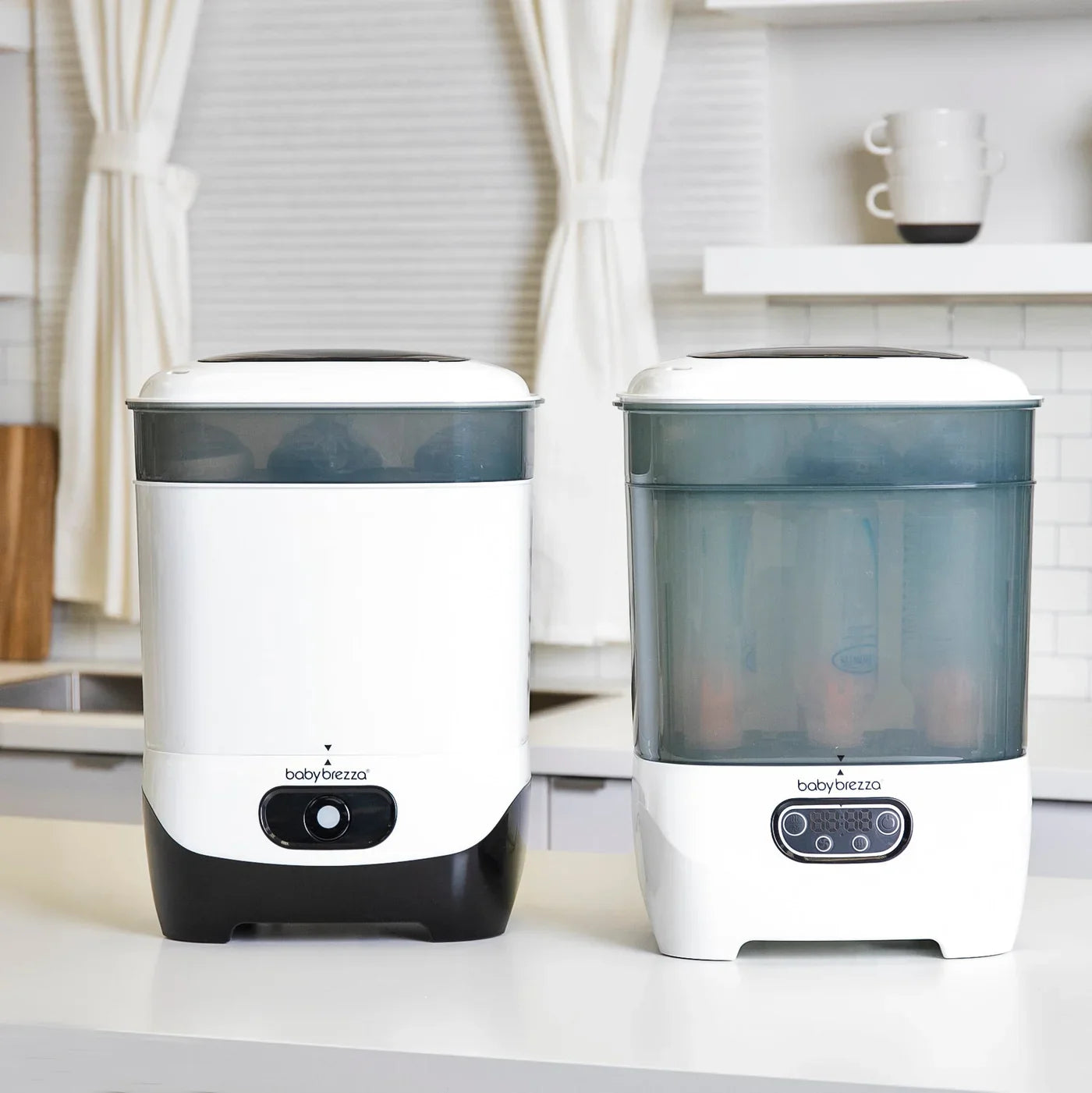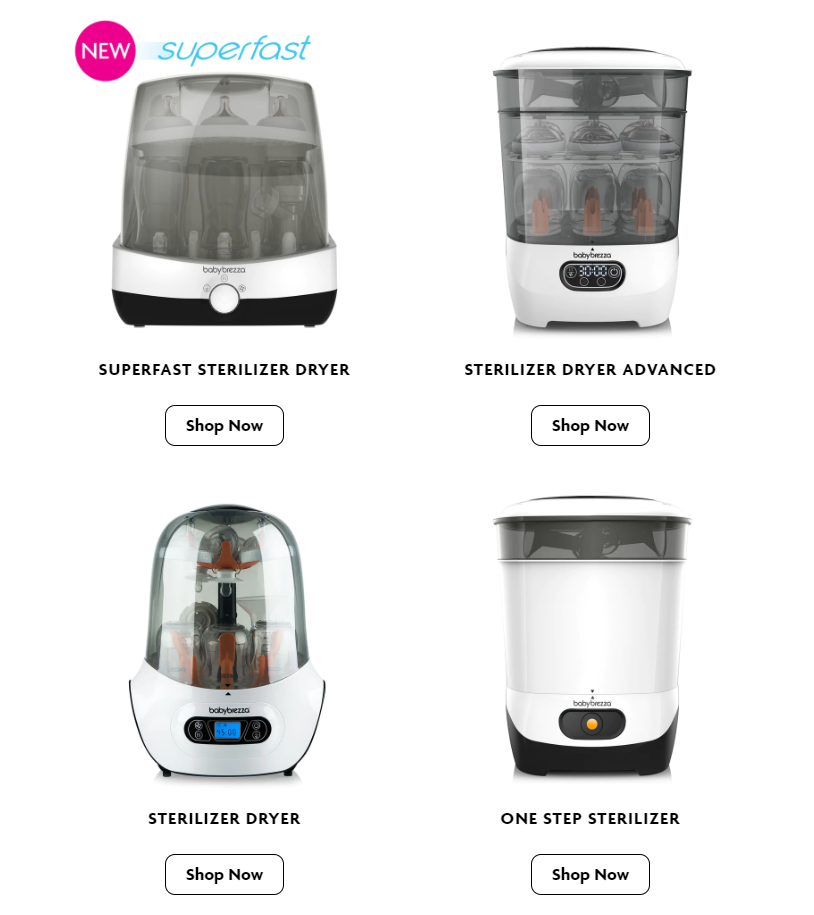Did you know there is a difference between sterilizing and sanitizing baby bottles, breast pumps, and more? In fact, there are three different levels to baby-product hygiene - cleaning, sanitizing, and sterilizing. The differences between the three are not arbitrary - the CDC recommends that you sterilize baby feeding items at least once a day with babies younger than three months. Knowing the difference between cleaning, sanitizing, and sterilizing can ensure that you keep your baby healthy.
Cleaning
Cleaning refers to the process of washing an item with soap and water to remove dirt, dust, allergens, and residue from visible surfaces. Think of this similar to how you clean your home - you don’t want dust to be floating around, but you also don’t need to deep-clean the tops of dressers or the inside of your desk every time you vacuum. Cleaning gets the surface-layer of dirt and grime clean, but leaves small particles of food and bacteria behind. Simply cleaning baby bottles will not sanitize or sterilize them.
Sanitizing
Sanitizing is a step up from the normal cleaning process, as it aims to remove microorganisms like bacteria, viruses, and more to a relatively “safe level”. This is often done after cleaning, like how you may rinse off excess tomato sauce from your plate after dinner before putting it into the dishwasher to be sanitized. As adults, we have had years to build up a strong immune system to protect ourselves from what germs and bacteria sanitizing does not reach. However, that “safe level” of remaining microorganisms for adults does not apply to a baby’s immune system. Babies, especially those younger than three months, may not be protected through sanitizing baby bottles alone. If you’re curious how to sanitize baby bottles, we encourage you to take the extra step to sterilize them instead. NOTE: Researching the difference between a bottle sterilizer and a dishwasher?Typically dishwashers only sanitize because the hot water used inside is not as hot as steam.
Sterilizing
Wondering the difference between sterilizing vs sanitizing baby bottles? Sterilizing means removing 99.9% of all microorganisms present on an item -- typically using steam. This is the gold standard approach to cleaning your baby's bottles and pump parts to ensure they are clean and safe to use. It's why the CDC recommends this and why maternity wards and NICUs (Neonatal Intensive Care Units) sterilize baby products.
Curious about how often you should sterilize your baby bottles and pacifiers? The CDC recommends that you sterilize baby feeding items, such as baby bottles, at least once a day with babies younger than three months. We recommend purchasing sterilizing equipment for babies so that you do not miss this crucial step.
Do You Need to Sterilize Baby Bottles, Pacifiers, and Breast Pumps?
In short, YES! Sterilizing baby bottles, pacifiers, breast pumps, and any other material coming into contact with your baby’s mouth or food can protect them from potentially harmful bacteria, one of the dangerous effects of not sanitizing baby bottles. And Baby Brezza makes it easy to do this with our line sterilizers and sterilizer-dryers. Read our blog to find the best approach for step by step sterilizing baby bottles.
Effects of not sterilizing baby bottles
It’s important for parents to keep baby bottles thoroughly sterilized for the entire first 12 months of a baby’s development. While it’s generally encouraged to always keep dishes, equipment, & food away from any potential contamination, the consequences for a baby’s health can be much more serious. Beyond common germs, mold, & mildew that can develop in the wake of not sterilizing, harmful viruses Hepatitis A and Rotavirus both have the potential to cultivate and spread if parents aren’t careful. Where Hepatitis can cause serious liver damage in early stages of growth, Rotavirus causes dehydration and diarrhea. Keeping a keen eye on routines and having the right sterilizer for your baby bottles are both key details to preventing any potential sickness or harm to your baby.
Step by step guide to sterilize baby bottles
The most common steps for baseline sterilization of baby bottles involves disassembling all bottles and boiling them upside down in water for five minutes; always check manufacturer’s notes or instructions to see if bottles should be boiled for more or less time, depending on what temperature each is designed to withstand. However, to ensure the most effective treatment is possible for sterilizing baby bottles, it is highly encouraged for parents to invest in a bottle sterilizer; this guarantees the process is completed correctly every time, from start to finish– putting both you and your baby at ease. Just disassemble, place each piece of equipment in the cleaning chamber, and press start; reassemble afterward and rest assured that your bottles are safe and ready to use.
When to stop sterilizing baby bottles (CDC)
The Centers for Disease Control and Prevention (CDC) recommends daily sanitization of infant feeding items, such as bottles, nipples, and breast pump parts, for babies under 2 months old, those born prematurely, or those with weakened immune systems.
For healthy infants older than 2 months, daily sanitization may not be necessary if feeding items are thoroughly cleaned after each use. Proper cleaning involves disassembling all parts, washing them with soap and water, and allowing them to air-dry completely. If using a dishwasher, select a hot water and heated drying cycle to effectively clean the items. While it may not be necessary to sanitize daily past 2 months old, sanitizing up to 1 year can help give parents peace of mind.
It's important to note that while the CDC provides guidelines on cleaning and sanitizing feeding items, it does not specify an exact age to stop sanitizing. The decision should be based on your baby's age, health status, and your comfort level. Consulting with your pediatrician can provide personalized advice tailored to your baby's needs.
Baby Brezza Sterilizer Collection
Baby Brezza offers a range of sterilizers and dryers to make this process easy for parents. Our sterilizers can be used with almost any bottle, and can also sterilize breast pump parts and pacifiers.
One Step Sterilizer Dryer Advanced
The One Step Baby Bottle Sterilizer and Dryer Advanced is our most advanced way to sterilize and dry baby products. It kills 99.9% of germs with steam, then automatically dries 33% faster. It also has the largest capacity of any sterilizer, holding 8 bottles and 2 full pump part sets. This revolutionary appliance also includes a HEPA filter so it dries with clean air that's 99.99% free of germs. And it's modular so you can use it 4 different ways.
One Step Sterilizer
The One Step Baby Bottle Sterilizer is a great option for parents who want a steam sterilizer but do not need an integrated dryer. This appliance has the largest capacity, holding up to 8 baby bottles and 2 pump part sets, and can used 4 different ways because it's modular.
One Step Baby Bottle Sterilizer Dryer
Our One Step Baby Bottle Sterilizer Dryer automatically sterilizes and dries up to 6 bottles, pump parts and accessories. This is a great option that takes up less counter space than our advanced dryer, but still dries in 45 minutes. The stainless steel heating plate protects against rust and hard water build-up, making maintenance easy for the lifetime of the device.
Superfast Sterilizer Dryer
Bottle Washer Pro
The Baby Brezza Bottle Washer Pro is the first and only appliance that automatically washes, sterilizes, and dries baby bottles and pump parts in one step. It uses high-pressure jets to scrub the inside of bottles and steam to kill 99.9% of germs, no pre-rinsing required. With a compact footprint, it holds up to 4 bottles plus accessories, making it an ideal time-saver for busy parents. Choose from multiple modes, including wash & dry, sterilize & dry, or dry only.






